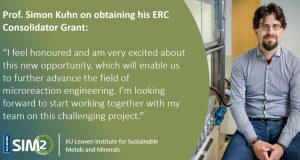On May 15, 2017, Mumin Enis Leblebici (SIM² KU Leuven, Department of Chemical Engineering) successfully defended and obtained his PhD degree at KU Leuven. The topic of Enis Leblebici PhD dissertation is “Design, modelling and benchmarking of photoreactors and separation processes for waste treatment and purification”. He obtained this degree in the framework of the Industrial Research Fund Knowledge Platform project RARE³ (Advanced Recycling and Reuse of Rare Earths and other Critical Metals). Dr. Leblebici’s main supervisor was Prof. Tom Van Gerven (KU Leuven), who is also the coordinator of the EU ETN COSMIC project on process intensification in the chemical engineering domain.
Publications in the context of this PhD:
- Leblebici M., Van den Bogaert B., Stefanidis G., Van Gerven T. (2017). Efficiency vs. productivity in photoreactors, a case study on photochemical separation of Eu. Chemical Engineering Journal, 310 (1), 240-248.
- Van den Bogaert B., Gheeraert L., Leblebici M., Binnemans K., Van Gerven T. (2016). Photochemical recovery of europium from non-aqueous solutions. Physical Chemistry Chemical Physics, 18 (43), 29961-29968.
- Leblebici M., Kuhn S., Stefanidis G., Van Gerven T. (2016). Milli-channel mixer and phase separator for solvent extraction of rare earth elements. Chemical Engineering Journal, 293, 273-280.
- Leblebici M., Rongé J., Martens J., Stefanidis G., Van Gerven T. (2015). Computational modelling of a photocatalytic UV-LED reactor with internal mass and photon transfer consideration. Chemical Engineering Journal, 264, 962-970.
- Leblebici M., Stefanidis G., Van Gerven T. (2015). Comparison of photocatalytic space-time yields of 12 reactor designs for wastewater treatment. Chemical Engineering and Processing, 97, 106-111.
Abstract
This work studies the design of photoreactors in two application fields, namely photocatalytic waste degradation in wastewater and photochemical waste purification from lamp phosphor waste. As regards the photocatalytic wastewater degradation, a computational model for immobilized catalyst reactors for micropollutant removal from wastewater has been developed and validated. The model does not only predict the apparent reaction rate, but is also able to calculate the concentration gradient within the catalyst coating and the free-flowing medium. Further on, the thesis focuses on the waste purification application and proposes a new mixer – phase separator for solvent extraction of Eu. The phase separation does not rely on gravity, but is based on differences in wettability. The study shows that as the reactor channel dimension increases, the space-time yield decreases. On the other hand, the throughput increases, which requires less need for numbering up to meet the industrial throughput. This work has also shown that the 30 min long mixing-settling process can be intensified such that it is completed in 10 s in industrial concentrations. A large part of the work has been devoted to the scale up of intensified systems and iterates on the optimization problem stated above. A new benchmark is proposed, namely the photochemical space-time yield (PSTY), which can compare waste degradation reactors of very different scales and sizes. Furthermore, PSTY is proven to predict the industrial applicability of a reactor as the pilot-scale reactors scored higher than the laboratory scale ones. Finally, a method was proposed to calculate the optimum reactor characteristic length for a case study of photochemical Eu precipitation. The results prove that PSTY is not only a benchmark, but also a design parameter. The irradiance in the reactor was also modelled with a newly developed model, which uses P1 approximation of radiative transfer equation in participating media and a simple empirical equation for the air medium.
More info about the RARE³ project?




